Believing Any Of These 8 Myths About Learning And Development In Organisations Keeps You From Growing
The Worst Greenhouse Gasses You Haven’t Heard Of
Carbon dioxide has long drawn the ire of an environmentally-conscious humanity. Released from combustion of fossil fuels, levels of CO2 in the atmosphere are higher now than at any point in the past 400,000 years. With the warming effects this has on the global environment, bringing these numbers down is a primary goal of scientists and policy makers worldwide.
However, this only tells part of the story. Carbon dioxide is not alone in its role as a greenhouse gas, with many others contributing significantly to global temperature rises. As humanity struggles to keep warming below 2 degrees C over the century, strategies will be needed to tackle the problem on all fronts.
There’s A Bad Smell Around Methane  Ruminant animals are a major source of greenhouse gas emissions, which is probably no surprise to some. Source: Wikimedia Commons
Ruminant animals are a major source of greenhouse gas emissions, which is probably no surprise to some. Source: Wikimedia Commons
Methane is a remarkably potent greenhouse gas, having 28 times the warming potential of CO2 by weight over a 100-year period. Historically, it’s mostly been released from natural sources, like bacteria processing organic material in stagnant watercourses, or from thawing permafrost. However, scientists now consider around 60% of methane in the atmosphere to be a direct result of human activity.
Agriculture is a major contributor in this area. Ruminant animals raised for human consumption are major methane emitters, as the microbes in their digestive systems release the gas when breaking down plant material. With the demand for meat and dairy showing no signs of slowing down, this could prove difficult to tackle. There are a variety of other diffuse sources of the gas, too. Landfills and sewage plants have significant methane emissions of their own, and it’s also often released from oil and gas drilling operations, too.
 Oil and gas operations release significant quantities of methane into the atmosphere, often due to leaks or plant malfunctions.
Oil and gas operations release significant quantities of methane into the atmosphere, often due to leaks or plant malfunctions.
Levels of methane in the atmosphere have been low compared to carbon dioxide. Methane also tends to have a short life in the atmosphere, of around 9 years. These factors have meant that methane has historically been of lower concern to environmental organisations. However, after levels plateaued from the 1990s to the mid-2000s, they have once again begun to climb precipitously. Scientists have yet to identify the cause of this rise, and it has the potential to undo hard-fought gains in the fight against global warming on the CO2 front. Theories range from a reduced level of chemicals that break down methane in the atmosphere, to increased livestock production or the rise of the hydraulic fracturing industry.
Whatever the cause of the recent rise, stemming the increase will require significant work. The Environmental Defence Fund is launching MethaneSAT in an attempt to better locate and quantify releases to the atmosphere, aiming to stem easily-fixed leaks in fossil fuel operations. Other ideas include using antibiotics to reduce animal’s methane output, or to capture the emissions from landfills and use them as an energy source. It’s likely a rigorous approach to both monitoring and emissions reduction will be required to keep methane levels in check.
Nitrous Oxide  Fertilizer use is a major contributor to nitrous oxide emissions.
Fertilizer use is a major contributor to nitrous oxide emissions.
Nitrous oxide isn’t just the favorite gas of the Fast and the Furious. It’s also a potent greenhouse gas, with 300 times the warming potential of carbon dioxide, pound for pound. With plenty of staying power, it sticks around in the atmosphere for 114 years on average. With 40 percent of NOx emissions coming from human activity, it’s a significant player as far as greenhouse gases go.
Fertilizer use in agriculture is the major contributor to nitrous oxide releases into the atmosphere. As farms push for ever-greater yields, there has been a corresponding increase in the use of nitrogen-containing fertilizers. Other lesser sources include fossil fuel combustion and various chemical production processes.
Reducing nitrous oxide emissions to any major degree is a difficult problem. Reducing farm yields is impractical if we wish to continue feeding as many people as possible. Increasing the efficiency of fertiliizer application is instead a more viable way to go. By applying fertilizers in the right way, in the right quantities at the right time, has the benefit of both reducing nitrous oxide emissions as well as cutting costs for farming operations. Other gains in this space can be made by reducing fossil fuel use by switching to renewable energy production, or cleaner burning technologies. The famous catalytic converter, introduced to gasoline-powered vehicles in the 1970s, plays a major role in reducing these emissions, and urea injection does much the same for diesel engines, which we’ve talked about before.
Sulfur Hexa-what now? 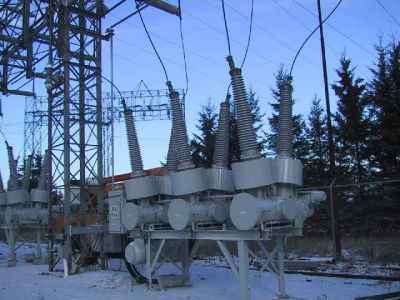 Sulfur hexafluoride is used heavily in high-voltage switchgear, as seen here in this hydroelectric installation. This circuit breaker is rated to run at 115 kV, 1200 A.
Sulfur hexafluoride is used heavily in high-voltage switchgear, as seen here in this hydroelectric installation. This circuit breaker is rated to run at 115 kV, 1200 A.
Recently, sulfur hexafluoride has come under scrutiny. Also known by its chemical formula, SF6, it’s a highly potent greenhouse gas, with a warming potential of over 23,000 times that of CO2. Prized for its performance as a gaseous dielectric medium, it’s used heavily in high-voltage circuit breakers in modern electricity grids. It enables the construction of much more compact switchgear, while remaining safe and reliable in operation.
Concentrations of SF6 have begun to tick up in recent times, raising alarm bells. Speculation is that this is down to leaks of the gas from electrical equipment. As the world’s energy mix changes, grids have come to rely on more distributed generation, from sources like wind farms and solar. This mode of generation necessitates many more connections to the grid, which means more switchgear, and thus more SF6 out in the wild.
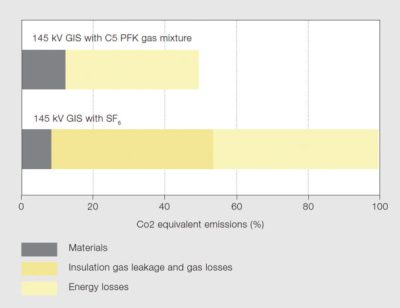 This graph shows the lifetime equivalent emissions of AirPlus versus SF6 technology. There are major gains to be had, thanks to the low global warming potential of AirPlus.
This graph shows the lifetime equivalent emissions of AirPlus versus SF6 technology. There are major gains to be had, thanks to the low global warming potential of AirPlus.
Work is afoot to slow this trend before things get out of hand. A replacement has been developed in a collaboration between ABB and 3M, by the name of AirPlus. While the production process releases more CO2, over the lifecycle of an installation, AirPlus-based switchgear should have far lower impact on warming. This is due to the fact that when released into the atmosphere, AirPlus degrades under UV light exposure in just 15 days, versus 3200 years for SF6. Its global warming potential is less than 1, meaning it has less of a warming effect than even CO2, while delivering comparable dielectric performance to SF6. Variants are available for both medium and high voltage applications.
Over time, as goverments work to reduce the prevalance of SF6 in new installations, its likely that we’ll see AirPlus and other alternatives gain steam. The gas has already been banned in the EU for all non-electrical purposes, since 2014. Industry is typically slow to act unless there’s a strong business case, so government intervention is likely to be the game changer that pushes adoption of newer, cleaner technology in this space.
Other Fluorinated Gases
SF6 is just one of a series of fluorinated gases that have significant global warming potential. Many of these were introduced as replacements for chlorofluorocarbons (CFCs), which tend to eat a hole in the ozone layer. Thankfully, that problem was largely solved when production of CFCs was tailed off in 1996, but their replacements can still cause further troubles.
With lifetimes in the hundreds to thousands of years in the upper atmosphere, gases like hydrofluorocarbons and perfluorocarbons have an outsized effect on atmospheric warming, thousands of times that of CO2 on a per-molecule basis. They have applications as aerosol propellants, solvents, and fire retardants, but their primary use is as refrigerants in cooling systems. HFC-134a is the most well-known, used widely in air conditioning systems worldwide, and particularly in motor vehicles. This has led to its position as the most abundant HFC in the atmosphere.
Efforts are in place to limit the impact of these chemicals, through precautionary measures. This involves taking more care during the repair and disposal of HVAC systems, as well as designing systems to be more resilient of leaks in the first place. Recycling methods are also beneficial to ensure that where possible, these gases are captured rather then simply vented to the atmosphere. Enforcement on a broad scale remains a challenge.
 Automakers are already planning to switch air conditioning systems to use gases that have less global warming potential. Source: Mercedes Benz
Automakers are already planning to switch air conditioning systems to use gases that have less global warming potential. Source: Mercedes Benz
Sometimes, it’s better to avoid the problem entirely. A transition away from using refrigerants like HFC-134a is in progress. The EPA has legislated that all light vehicles manufactured or sold in the USA by model year 2021 must no longer use HFC-134a. Instead, alternatives like HFO-1234yf, HFC-152a, and R-744 will be legal. The first two are mildly flammable, while the latter is simply another name for good old CO2. These refrigerants will require different technology to existing air conditioners. CO2-based systems in particular needing to operate at up to 10 times the pressure of traditional systems. However, progress in technology should allow these gases to take over, reducing the impact these refrigeration gases have on global warming.
The Fight Continues
CO2 is still the primary greenhouse gas, but it’s not the whole story. We’ve looked at a wide variety of chemicals, each with their own important roles and impact on the Earth’s atmosphere. This highlights the fact that there’s no single panacea to heading off global warming; instead, a broad spectrum approach across all aspects of human endeavour is required.
Halting the impacts of these chemicals is difficult, and will require decisive action by both government bodies, as well as cooperation from relevant industries. In some cases, there are additional gains to be had, while in others, the solution comes with high costs and painful changes. We engineered ourselves into this situation, so we can probably engineer ourselves out. Regardless, if humanity is to flourish in the next century, there remains much work to be done.
Why Is Continuous Glucose Monitoring So Hard?
Everyone starts their day with a routine, and like most people these days, mine starts by checking my phone. But where most people look for the weather update, local traffic, or even check Twitter or Facebook, I use my phone to peer an inch inside my daughter’s abdomen. There, a tiny electrochemical sensor continuously samples the fluid between her cells, measuring the concentration of glucose so that we can control the amount of insulin she’s receiving through her insulin pump.
Type 1 diabetes is a nasty disease, usually sprung on the victim early in life and making every day a series of medical procedures – calculating the correct amount of insulin to use for each morsel of food consumed, dealing with the inevitable high and low blood glucose readings, and pinprick after pinprick to test the blood. Continuous glucose monitoring (CGM) has been a godsend to us and millions of diabetic families, as it gives us the freedom to let our kids be kids and go on sleepovers and have one more slice of pizza without turning it into a major project. Plus, good control of blood glucose means less chance of the dire consequences of diabetes later in life, like blindness, heart disease, and amputations. And I have to say I think it’s pretty neat that I have telemetry on my child; we like to call her our “cyborg kid.”
But for all the benefits of CGM, it’s not without its downsides. It’s wickedly expensive in terms of consumables and electronics, it requires an invasive procedure to place sensors, and even in this age of tiny electronics, it’s still comparatively bulky. It seems like we should be a lot further along with the technology than we are, but as it turns out, CGM is actually pretty hard to do, and there are some pretty solid reasons why the technology seems stuck.
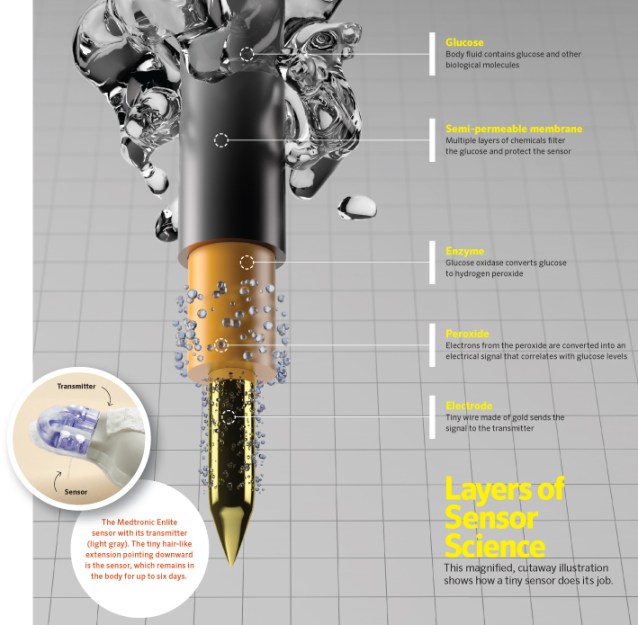 CGM sensor cutaway. Click for larger view. Source: Diabetes Forecast
CGM sensor cutaway. Click for larger view. Source: Diabetes Forecast
CGM systems are composed of three main pieces: the sensor itself, which changes glucose concentration in the body to an electrical signal; the transmitter, which conditions the signals and encodes it for wireless transmission; and the receiver, which can be a standalone unit or built right into an insulin pump, and displays the current readings and a chart of the glucose trend over the last 24 hours.
The sensor is the key to the whole thing. The chemistry behind it is simple: an ultrafine gold wire is covered with glucose oxidase, an enzyme derived from the bacteria Penicillium notatum. This enzyme oxidizes glucose into D-glucono-1,5-lactone and hydrogen peroxide. The peroxide then oxidizes on the gold wire, resulting in a current proportional to the glucose concentration in the interstitial fluid. This current is read by the system and used to calculate an estimate of the blood glucose concentration based on a calibration curve.
But while the chemistry is straightforward, human biology and manufacturing challenges make a practical CGM sensor difficult. First and foremost, CGM sensors must be inserted into the interstitial fluid and live there for up to a week (although many of us stretch that out considerably to save on sensors). As a foreign object inside the body, a wire coated with proteins derived from a bacterium would be red meat to the immune system, which is designed to mop up exactly this kind of foreign invader. Without some kind of protection, the glucose oxidase that makes the sensor work would be destroyed by the immune system in a matter of hours. This requires special, proprietary coatings over the sensor that can allow glucose in but prevent the immune system from attacking the enzyme, at least for a while.
The other difficulty involves handling tiny components and assembling them into an interface for the transmitter that will digitize the signals from the sensor and send them wirelessly to the receiver. The interface has to provide both a place for the transmitter to mate and a way to adhere to the skin reliably for weeks at a time without causing any kind of contact dermatitis or other side effects. The sensor also needs to be mated to some kind of introducer, a thicker hypodermic needle through which the fine, floppy sensor wire can pass, so it can be inserted without bending. The finished assembly also has to be sterilized, of course, so it has to be able to withstand the rigors of irradiation, the most common method of sterilizing medical devices.
The Transmitter 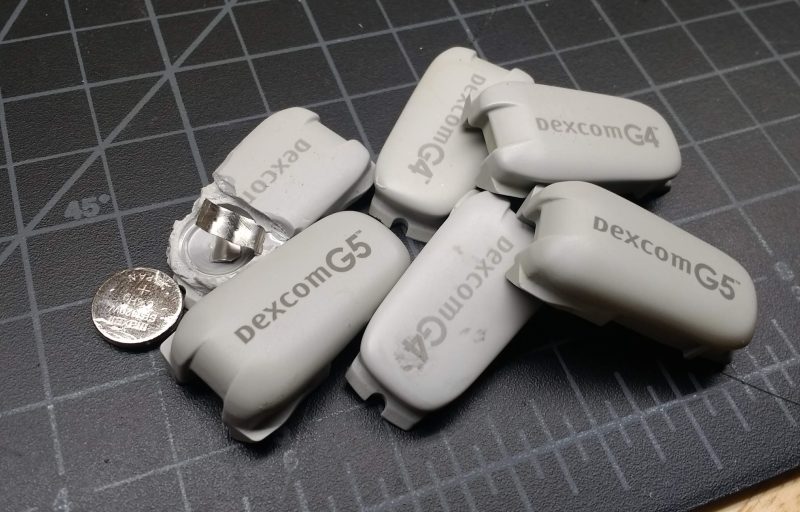 My collection of dead transmitters, including on I opened. Along with my daughter’s current transmitter, this represents about $5,000 worth of gear that insurance doesn’t pay for.
My collection of dead transmitters, including on I opened. Along with my daughter’s current transmitter, this represents about $5,000 worth of gear that insurance doesn’t pay for.
All things considered, the $75 we pay for each CGM sensor probably isn’t too unreasonable. Where the value proposition starts to break down for me is the transmitters. Designs vary between manufacturers, and even within a manufacturer’s offerings as new technology supplants the older stuff. Schematics are hard to come by, of course, but the FCC ID database and a wealth of teardowns by frustrated users show that the basic guts of the transmitters we use are about what you’d expect from any wireless technology – signal conditioning for the sensor, a microcontroller, some power management stuff, and a wireless subsystem. The transmitters we’re using now use the 2.4-GHz ISM band; we’ve also used transmitters that speak Bluetooth, but those transmitters last only a quarter of the time the older ones do.
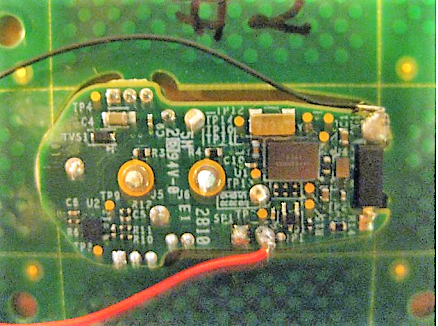 $600? Really? Inside view from the FCC ID database.
$600? Really? Inside view from the FCC ID database.
Looking at these teardowns, it’s hard to swallow that the $600 check I write to buy each one of these things is money well spent. We all know just how little these things actually cost to manufacture – probably far less than $5 a unit, and that’s really being generous. And yes, I know that I’m not paying for the components and the labor to put them together – I’m paying for the billions in R&D and clinical tests that it took to bring these devices to market. But I can’t help but think there has to be a better way.
The basic problem is that these transmitters are sealed units. I mean really sealed – the resin capsule is injection molded completely around the PCBs, with no way to open it non-destructively. And with no way to open the case, when the batteries inside finally die, all you can do is replace it. This hasn’t kept intrepid hackers from replacing the batteries, of course; I haven’t tried yet, but it’s on my to-do list. Once the sensor is opened up it’s pretty simple to slip in new batteries, but sealing the sensor again so that it stays waterproof is a bit of a challenge.
In the Blink of an Eye 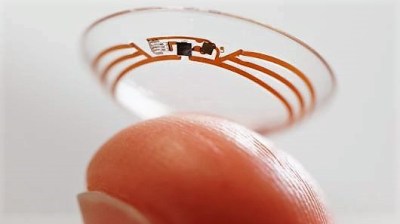 Verily’s prototype CGM contact. Source: Google
Verily’s prototype CGM contact. Source: Google
But does it have to be that way? Is it really necessary to have a relatively large, bulky transmitter like that? Seems to me that the transmitter could be much smaller and much cheaper if it used some sort of RFID technology. An external transmitter could interrogate the sensor and receive back the tiny bit of data needed to encode the current sensor voltage. That seemed to be the way Verily, the Google-owned medical devices company, was going with their sensor-equipped contact lenses for CGM. The idea seemed solid, since glucose is excreted in tears, and results in one of the early symptoms of Type 1 diabetes onset – blurry vision dues to sugar crystals on the cornea. The contacts would certainly not have a battery on board, so it would have to be remotely powered.
Sadly, though, Verily just announced they’re throwing in the towel on CGM contacts, stating that the biological hurdles to getting a stable, diagnostically useful reading were just too great to surmount. As we’ve seen, CGM is not easy, but I have a hard time believing that Verily bailed on this for purely technical reasons. With my cynical hat on, I’d say that the prospect of jumping through endless regulatory hoops was just too much for the company to bear, which is a crying shame (sorry) for such a seemingly breakthrough technology. But it’s tough to go up against established players that already have regulatory approvals and have deep pockets to boot.
Still, I’m hopeful that someone will pick up the challenge of building a better CGM. It’s not bad now, and at the end of the day I’d probably do whatever I had to do to keep my kid cyborged up. It’s just a shame that the CGM companies know this, and don’t feel particularly compelled to be a little more generous on pricing for a captive market.
Ethics and Governance of AI
The rapidly growing capabilities and increasing presence of AI-based systems in our lives raise pressing questions about the impact, governance, ethics, and accountability of these technologies around the world. How can we narrow the knowledge gap between AI “experts” and the variety of people who use, interact with, and are impacted by these technologies? How do we harness the potential of AI systems while ensuring that they do not exacerbate existing inequalities and biases, or even create new ones?
At the Berkman Klein Center, a wide range of research projects, community members, programs, and perspectives seek to address the big questions related to the ethics and governance of AI. Our first two and half years of work in this area are reviewed in "5 Key Areas of Impact," and a selection of work from across our community is found below.
Comments
Post a Comment